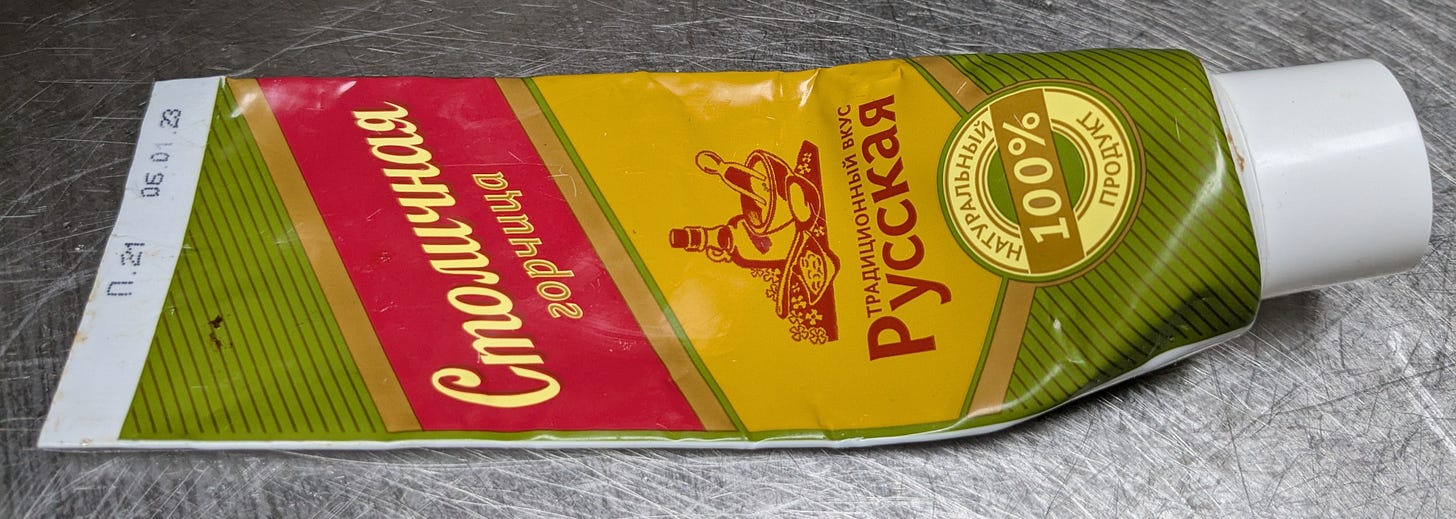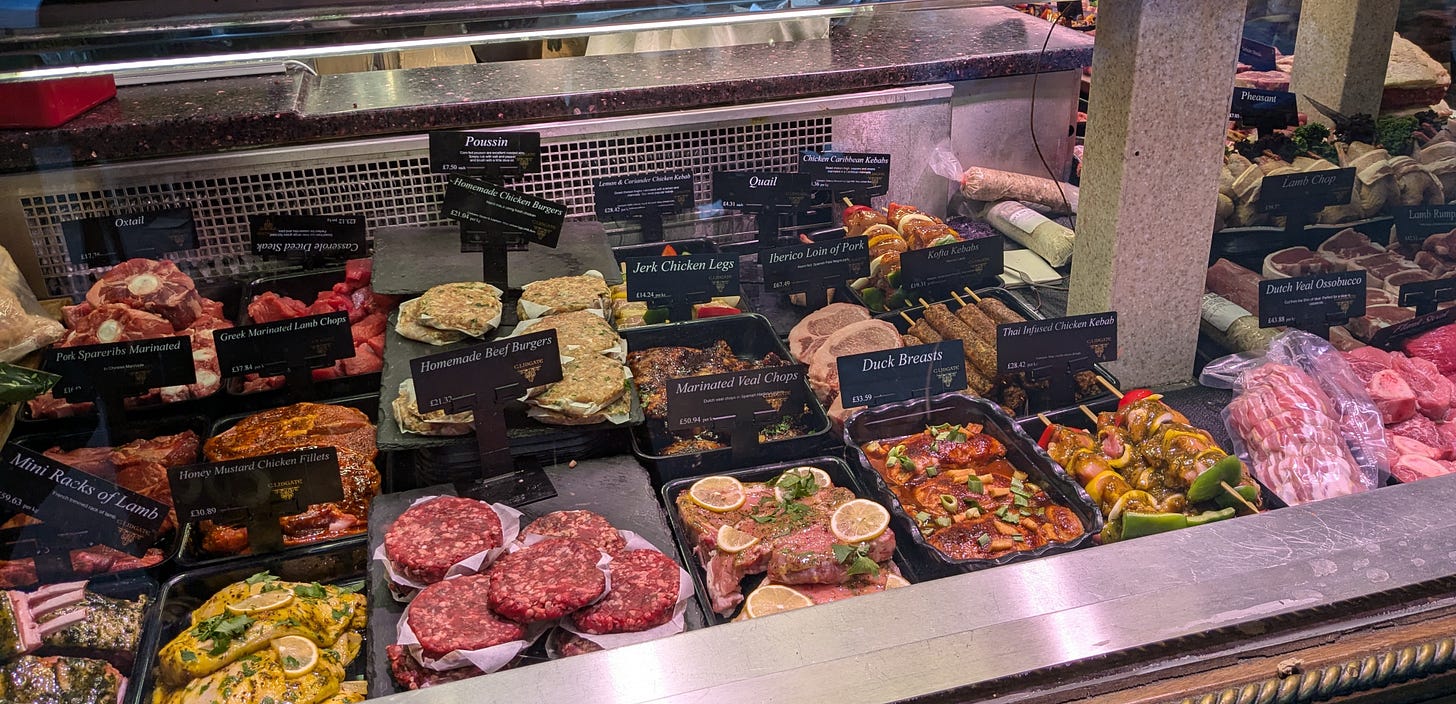I don’t know what it is about February, but it leaves me craving mustard. When cloud is pressing down over the skyline or it’s still dark as pitch when I stagger out to work, I fantasise about sausages, proper ones, cooked as slowly as possible so their juices caramelise on their skins.

I want to smear one with Colman’s English Mustard, the brand that makes your eyes water, and shove it between six inches of warm and crispy baguette smeared thickly with ice cold butter, to munch along freezing streets on the way to the bus. But if it’s 7 a.m and I were to achieve all the above, I’d have to set my alarm for 5.45 a.m., not the already challenging 6.30. Besides, my mother taught us never to eat in the streets and it still makes me feel uncomfortable.
Obviously, the quality of the sausage is key. But so is the mustard.
As a foreign correspondent in Moscow, I once wrote a piece suggesting if I were the Minister of Trade, there were three products I’d push to export:
Raketas: incredibly fast river police vessels that looked like the rockets they were named for;
Borjomi: a Badoit-style fizzy-water with a mineral taste from Georgia, filtered from the glaciers covering the peaks of Bakuriani mountains, which you can now find in the west;
and gorchitsa: the Russian for mustard.
The word comes from ‘gorit’, meaning ‘to burn’. Which it does. If you had a chest infection, you hastened to the pharmacy for a packet of gorchichniki mustard powder which you would add to a little water to create a compress to smear over your chest.
Not a treatment to dismiss. Pythagoras recommended mustard poultices for scorpion stings, and Hippocrates used them to treat lung infections. Johnson & Johnson manufactured them commercially until more modern solutions were found.
Mustard is made from ground mustard seeds, not the plants. I don’t think I’ve ever been offered mustard with my momos, but Nepal produces the world’s greatest supply of mustard seeds at 220,250 tonnes, way above the US’s 37,108 tonnes and the UK’s 7,500 to 10,800.
Mustard seeds were familiar in Russia through its trading ties with Constantinople. But it was a Protestant religious group which introduced the prepared condiment to the Russians. Thanks to an invitation from Catherine the Great, the Moravians migrated in the 18th century from the town of Herrnhut in Germany to Sarepta near what’s now known as Volgograd to provide a buffer zone against the marauding tribes from the steppes. The Lower Volga where they settled was a region where wild mustard grew prolifically.
If the Moravians had any expectations of bringing Christianity to the Tartars, Kazakhs and Kalmyks, it didn’t work. However, they did bring Russia its first prepared mustard factory, to Sarepta in 1810, which still exists. Russia had been buying its mustard from the English, but Napoleon’s continental blockade prevented British ships from exporting goods.
If you’re a regular reader of Tabled, you’ll have heard this before about so many of today’s foods: Mustard is nothing new.
Mustard seeds have been found in a seed cake dating between 9224 and 8753 BC from Jerf el Ahmar, the Pre-Pottery Neolithic site in Syria. In the court of the Zhou Dynasty in China (1046-256 BC), yellow mustard seeds were ground down and made into a paste used as a digestive during royal feasting, to whet the appetite for the extensive courses still to come.
The Romans made mustard. According to a recipe in De re cocquinaria, a collection of Roman cookery recipes compiled in 5 BC, they mixed together ground mustard, black pepper, caraway seeds, toasted coriander seeds, lovage, dill, celery, thyme, oregano, onion, honey, vinegar, fish sauce (garam) and oil, and used it to baste a spit-roasting boar.
Mustard-making in France began not in Dijon but in Paris, in the 10th century when the monks of Saint-Germain-des-Prés started producing it. Although mustard-makers were listed on the royal registers in Paris in 1292, Dijon had become the recognised mustard-making centre. There is an account of guests at a gala in 1336 of the Duke of Burgundy consuming 320 litres/676 pints of mustard crème - which might not differ from this week’s recipe.
Maurice Grey, a mustard-maker, partnered in 1877 with his financial backer, Auguste Poupon, to produce Grey-Poupon, which was granted an Appellation d'origine contrôlée in 1937. His recipe was a secret but said to include white wine. That seems probable as the name comes from ‘must’, the ‘moût’ of moutarde, the mix of grapes, their leaves and stems that’s made before yeast is added to turn it into alcohol. To this day, that ‘must’ is often added to posh mustard, particularly in France.
Still, Dijon mustard is sissy, in my view. A mustard needs to bring tears to the eyes. Colman’s does, even more than gorchitsa.
Don’t buy the ready made – buy the powder and make it up yourself stirring in teaspoons of water, little by little.
It began life in 1814 as a powder invented by Jeremiah Colman, a flour miller, and it is said the Colmans made their fortunes from the mustard that was left on the side of the plate. The bracing strength of it will make your nose run but the Colman cut of the global market should not be sniffed at: in 2023, it was estimated at $6.3 billion and is expected to rise over 6 percent more by 2030.
Mustard wasn’t widely known in the US until the 1904 St Louis World’s Fair when French’s Classic Yellow Mustard was served over hot dogs by George and Francis French. Its colour matches Colman’s but its pungency doesn’t come close.
If you plan to cook with mustard, you should stick to Dijon where it does come into its own.
This mustard sauce works not just with a thick pork chop or a roasted game bird, but if you just want to pour it over mashed potatoes, it’s delicious. I’ve even had it alongside a piece of pan-fried line-caught salmon.
25g/1½ tablespoons butter
1 tablespoon oil
2 large cloves garlic, unpeeled
2 thick spare rib or chump chops, 1½ cm/1 inch thick
glass white wine
150ml/5 fl oz double or whipping cream
1½ tablespoons grain mustard
1½ tablespoons smooth Dijon mustard
heaped tablespoon capers (optional)
Melt the oil and butter over medium low heat. Smash the garlic and add it with the chops to the fats. Brown one side then the other then lower to the heat to cook the chops through.
Move to a warmed plate then add the wine to the pan, scraping up the caramel to dissolve it. Let the liquid thicken then beat in the cream, followed by the mustards. Add the capers if using, return the chops to the pan and turn them a couple of times in the sauce then serve with mashed potatoes.







wow...love the histories you bring us, Julia!
Reading your delightful essay brought back memories of childhood mustard plasters, and being made to stay in bed with any minor ailment, inhaling from a small, boxy humidifier on the bedside table next to me, which exuded a small cloud of steam redolent of Vick's Vapo-Rub. Your mustard sauce recipe, with the addition of chopped cornichons to the capers, becomes my favorite Sauce Charcutiere for pork chops. And I add an additional fillip of copped fresh herbs--parsley, thyme, roasemary, and chives. I learned that wonderful amalgam of whole grain and Dijon mustards, pickles, and capers with pork from the Swiss chef at a French restaurant in Marlboro, VT, where I waited tables in the early 1970s.